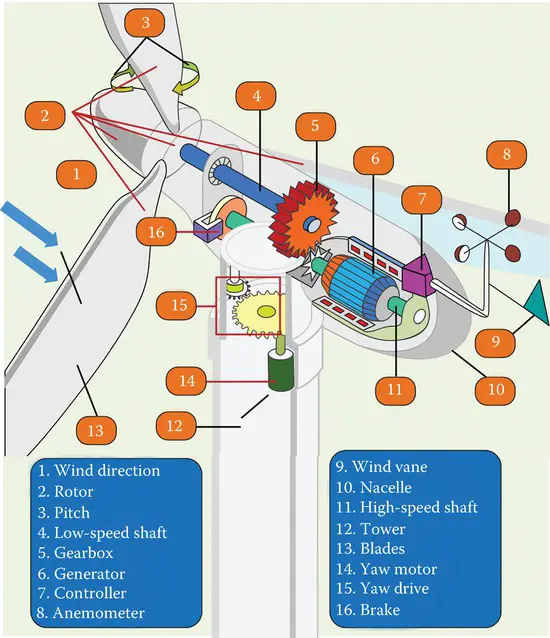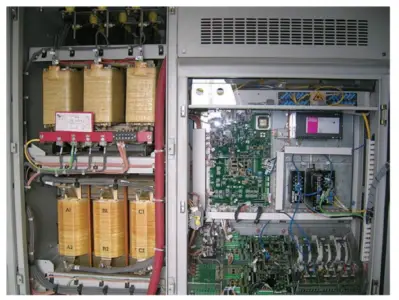A wind turbine consists of five major and many auxiliary parts. The major parts are the tower, rotor, nacelle, generator, and foundation or base. Without all of these, a wind turbine cannot function.
Foundation
The foundation is under the ground for the onshore turbines; it cannot be seen because it is covered by soil. It is a large and heavy structured block of concrete that must hold the whole turbine and the forces that affect it.
For offshore turbines, the base is under the water and cannot be seen. In offshore turbines that are well into the sea the base is floating, but it is of sufficient mass to support the turbine weight and all the forces exerted on it and to hold it upright.
Tower
The tower in most modern turbines is round tubular steel of a diameter of 3–4 m (10–13 ft), with a height of 75–110 m (250–370 ft), depending on the size of the turbine and its location. The rule of thumb for a turbine tower is that it has the same height as the diameter of the circle its blades make when rotating. Normally, the taller a turbine is, it is subject to more of the wind with higher speed. This is because the farther we are from the ground, the faster the wind (wind does not have the same speed at various distances from the ground).
Rotor
The rotor is the rotating part of a turbine; it consists of (mostly) three blades and the central part that the blades are attached to, the hub. A turbine does not necessarily have to have three blades; it can have two, four, or another number of blades. But the three-blade rotor has the best efficiency and other advantages.
Blades are not solid; they are hollow and are made of composite material to be light and strong. The trend is to make them larger (for more power), lighter, and stronger. The blades have the form of an airfoil (same as the wings of an airplane) to be aerodynamic. As well, they are not flat and have a twist between their root and their tip. The blades can rotate up to 90° about their axes. This motion is called blade pitch.
Hub
The function of the hub is to hold the blades and make it possible for them to rotate with respect to the rest of the turbine body.
Nacelle
The nacelle is housing on top of the tower that accommodates all the components that need to be on a turbine top. There are quite a number of components for the proper and healthy operation of a complicated electromechanical system that a turbine is. A major turbine part among these components is the generator and the turbine shaft that transfers the harvested power from wind to the generator through a gearbox.
The gearbox is a vital component of wind turbines; it resides in the nacelle. A gearbox increases the main shaft speed from around 12–25 rpm* (for most of today’s turbines) to a speed suitable for its generator. For this reason, the shaft on the generator side is called “high-speed shaft.”
Because a turbine must follow the wind and adjust its orientation to the wind direction, its rotor needs to rotate with respect to the tower. This rotation is called yaw motion in which the nacelle and the rotor revolve about the tower axis.
Generator
The generator is the component that converts the mechanical energy of the rotor, harnessed from wind to electrical energy. A generator has the same structure as an electric motor.
At the commercial production level, all electricity generation is in the three-phase alternative current. In general, the choice of generator, therefore, is synchronous or asynchronous (induction) generator. Nevertheless, the generator associated with wind turbines, thus far, is the induction generator because a synchronous generator must turn at a tightly controlled constant speed (to maintain a constant frequency). Some of a wind turbine’s principal components are depicted in Figure 1.
Because a generator must be rotated at a speed corresponding to the frequency of the electric network (50 or 60 Hz in most countries), it must be rotated faster than the turbine rotor. Most generators need to be turned at 1500 rpm (for 50 Hz) and 1800 rpm (for 60 Hz). In no way, it is feasible for a turbine rotor to move that fast. A gearbox, therefore, must increase the turbine rotor (main shaft) rotational speed to a speed that can be used by the generator.
Experience has shown that the gearbox in a turbine is a problematic component. This is due to the fact that the energy in the wind does not remain constant for a relatively acceptable length of time. It continuously fluctuates, because of the nature of wind. This causes the gear teeth to undergo overload and hammering stress that leads to fatigue and failure. In addition, the gearbox is a heavy item in the nacelle on the top of a turbine.

Figure 1. Wind Turbine Parts/Components: tower, rotor, nacelle, and foundation (underground).
A wind turbine is a complex system to control because the source of power (wind) is not in our control. Wind speed can continuously change, even from one second to the next. The power output from a turbine, therefore, must be adjusted to the variation of wind at all times.
All new turbines are equipped with pitch control, which implies that their blades’ pitch angle can be adjusted so that the power output from a turbine is maximized at all times, while it does not overload the generator and mechanical structures of the blades, tower, and the rotor shaft.
The way this adjustment of power to wind speed is carried out is that each turbine has a performance curve called power curve. It is used as a power schedule by a computer in the turbine control system to adjust all components that need to be controlled, based on this curve and according to wind speed. A typical sample of this curve is shown in Figure 2 (to obtain wind speed values in miles per hour multiply the values in m/sec by 2.2).
Figure 3 depicts part of the components inside the control panel in a wind turbine. This control panel is normally at the bottom and inside the tower.

Figure 2 Typical power curve for a wind turbine.

Figure 3. Part of the control circuitry for a wind turbine.
Wind Turbine Parts FAQs
What are the main components of a wind turbine?
The main components of a wind turbine include the rotor, generator, tower, nacelle, and control system.
What is the function of the rotor in a wind turbine?
The rotor, also known as the blades or propellers, captures the kinetic energy of the wind and converts it into rotational motion.
What does the generator do in a wind turbine?
The generator converts the rotational motion of the rotor into electrical energy through electromagnetic induction.
What is the purpose of the tower in a wind turbine?
The tower provides height and stability to position the rotor at an optimal height to capture stronger wind speeds.
What is the nacelle in a wind turbine?
The nacelle is the housing or enclosure that contains the main components of the wind turbine, such as the rotor, generator, and control systems.
What role does the control system play in a wind turbine?
The control system regulates the operation of the wind turbine, including starting and stopping the turbine, adjusting blade pitch, and optimizing power generation.
How important is regular maintenance of wind turbine parts?
Regular maintenance is crucial to ensure the efficient and safe operation of wind turbines. It helps detect any potential issues, prolongs the lifespan of the components, and maximizes power generation.